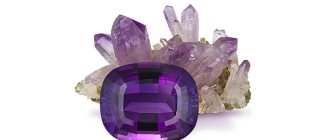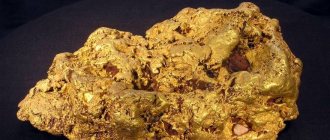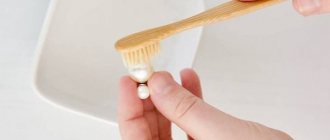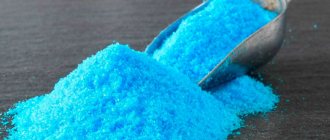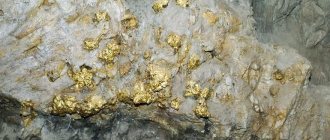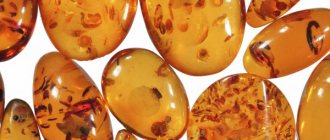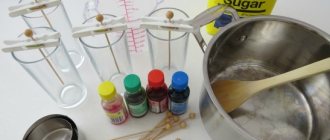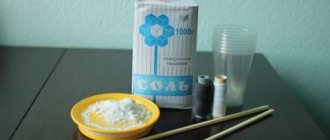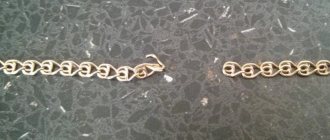Precious stones are used for more than just jewelry. Purchasing them is a popular way to invest your earnings. The price of diamonds, sapphires, emeralds and rubies remains consistently high, and the stones themselves can be stored for many years and passed on by inheritance. To make jewelry more accessible, scientists are developing and improving technologies for producing synthetic jewelry stones. Some jewelry lovers are also looking for ways to grow diamond and other crystals at home.
Gemstone production technologies
The first attempts to make artificial gems date back to 4000 BC. e. These were beads covered with blue enamel, imitating lapis lazuli. Later, analogues of precious stones were made from colored glass, then from plastic. The first experiment, as a result of which scientists managed to grow the mineral, dates back to the 19th century. In his laboratory, the Frenchman Marc Gaudin obtained small crystals of ruby, trying to reproduce natural crystallization processes.
Modern scientists have access to all the knowledge of their predecessors, precision instruments and installations capable of creating very high temperatures and pressures. Chemists and physicists practice many methods to produce synthesized stones, including diamonds. The basis for obtaining them can be:
- melts;
- solutions;
- gaseous media.
Accordingly, a crystal can be grown either by transforming the original solid or by creating a sample from the liquid or gaseous phase.
One of the most complex technologies is obtaining diamonds. The development of methods for its synthesis was based on the fact that diamond has the same composition as graphite. But getting one substance to change into another is not easy. To make a diamond, a temperature of 1600 ℃ or higher and a pressure of about 110,000 atmospheres will be required. There are untested folk methods for producing diamonds from graphite at home using electricity or explosives, but the likelihood of their successful use tends to zero.
To achieve jewelry quality from the resulting diamond, an even more complex industrial technique will be required, the specifics of which manufacturers do not disclose.
For the first time, gem quality stones were obtained in 1970 in America.
The safest method that can be tried to grow a diamond outside the laboratory requires the use of the following components and equipment:
- pencil lead;
- the wire;
- liquid nitrogen or water;
- voltage source.
Each end of a piece of graphite must be wrapped with wire and the lead must be frozen in liquid nitrogen. If liquid nitrogen is not available, you can place the workpiece in a container of water and freeze it. The next step is to connect the ends of the wire to a voltage source and conduct current through the lead. As a result, graphite should turn into diamond, that is, acquire its hardness.
Making artificial emerald
To make an artificial emerald at home, you should use the hydrothermal method of growing this stone. This method will require the purchase of appropriate equipment - an autoclave that can withstand high temperatures and pressure. Here, as in the case of a unit for growing rubies, you need to turn to specialists - in any case, you need to buy a high-pressure autoclave that is properly designed and manufactured in an industrial environment.
The process of growth of emerald crystals occurs as follows:
- The autoclave gradually heats up.
- Crushed beryl is dissolved in the hot compartment, which is used as a seed. The process takes place in an aqueous environment with the addition of vanadium and chromium, which impart a natural color to the future stone.
- As soon as the temperature reaches 600 C and the pressure reaches 1.5 Kbar, the crushed beryl dissolved in the hot compartment is transferred to the cold zone of the autoclave, where it settles layer by layer on the seeds, forming an artificial emerald.
The manufacturing technology takes four weeks. The size of artificial emerald obtained in this way is limited by the volume of the autoclave. Despite the expensive production process, the payback is incredibly high! In addition, using this method, you can grow beryl and sapphires of various shades, as well as aquamarine and ruby.
Fact! The global community of gemstone traders puts artificial emeralds produced by hydrothermal methods on a par with natural analogues!
Organic salts
To synthesize crystals from solutions, organic salts are used as a base. From these substances, called alum, Marc Gaudin obtained ruby crystals. To do this, he fused potassium and aluminum sulfate with potassium chromate.
Using some of the substances, chemistry enthusiasts grow crystals on their own. For example, at home, beautiful bright blue crystalline formations are obtained from copper sulfate . In addition, to independently grow minerals of various colors, you can use:
- potassium chloride;
- inkstone;
- nickel sulfate;
- potassium alum;
- Mohr's salt;
- potassium nitrate and some others.
When choosing a suitable reagent, take into account that it must meet the following requirements:
- dissolve in water or other solvent;
- be stable to temperature increases;
- does not pose a health hazard when used correctly.
The technique for growing crystals from organic salts is based on the preparation of supersaturated solutions followed by crystallization in an open container. The process of obtaining a beautiful “stone” takes more than one month and consists of several key steps.
Preparation of mother liquor
This stage includes a number of actions:
- Pour 700–800 ml of sufficiently hot water, the temperature of which is 50 ℃, into a 1 liter heat-resistant glass.
- Gradually - 1 tablespoon at a time - add the selected substance and mix the composition until the powder is completely dissolved.
- When the solution becomes saturated, that is, the substance stops dissolving, add another 2 tablespoons and leave for 24 hours.
- To prevent foreign particles of dust from getting into the liquid, the container can be covered with a sheet of filter paper.
Obtaining the seed
Includes several steps:
- First, you will need to pour the resulting liquid into a heat-resistant flask, passing it through a filter, and add 1 teaspoon of a substance, which can be the crystals that precipitated in the initial solution.
- In order for the substance to dissolve, it is recommended to heat the container in a water bath at a temperature no higher than 60–70 ℃.
- Rinse a clean container with boiling water so that it heats up to the same temperature as the solution, and pour the liquid into the container.
- Wrap the container in a cloth, such as a towel, cover with filter paper and let cool.
- When the composition becomes cool, small crystals form on the bottom and walls of the glass, from which you need to choose one, which will become the basis of the future “jewel”.
Getting the stone
The single crystal will be grown from the obtained seed:
- The sample you like should be tightly wrapped with thread or fishing line.
- The other end of the thread can be wound around a stick or pencil, which will serve as a support.
- Place the seed in a glass with a solution at room temperature.
- The crystal grows gradually; during this period it cannot be pulled out or turned. If the liquid evaporates, exposing the “stone,” you will need to add more solution.
- After the crystal reaches the desired size, it should be carefully removed and placed on a napkin.
Sometimes grown samples are subject to weathering, that is, they are destroyed by evaporation of the crystallization liquid and turn into powder. They can be preserved in paraffin or under a layer of vegetable oil.
Some experts recommend covering the surface of the crystal with 2 layers of clear varnish
Auguste Verneuil method
At the end of the 18th - beginning of the 19th centuries, a scientist from France, Auguste Verneuil, developed a new method for producing artificial rubies, also called “melting in a flame.” This method marked the beginning of the stage of industrial synthesis of precious stones. They began to be used not only in jewelry, but also in the production of watches, measuring instruments and for other technical purposes.
Verneuil designed and tested a structure consisting of an oxygen-hydrogen torch, a powder dispenser from which the gem would be synthesized, and a ceramic base. In such an oven, a crystal 40–50 mm long can be grown in 3–4 hours. Depending on the chemical composition of the powder, stones of various colors are obtained, as well as their star-shaped varieties.
However, it will not be possible to grow a diamond at home using this technique; as a rule, corundums (rubies and sapphires) and spinel are synthesized this way. The Verneuil device produces synthetic titanite strontium and rutile, which can compete with diamonds in brilliance, but are less hard. High-quality imitation diamonds are also garnetites, lithium niobate and cubic zirconia.
How to grow ruby crystals synthetically?
Growing ruby crystals can even be a home business option. After all, beautiful synthetic stones are already in great demand among buyers, so if the project is successfully implemented, they can bring you a good profit. Synthetically grown stones are used by jewelers and are also widely used in technology.
Ruby crystals can be grown using standard methods by selecting the right salts. But this will not be as effective as in the case of salt or sugar, and the growth process takes much longer. And the quality will be questionable. After all, a natural ruby on the Mohs hardness scale is second only to Diamond, occupying an honorable 9th place. Naturally, when it comes to business, in most cases they use a different method, developed more than 100 years ago in France.
Device for working at home
To master the cultivation of precious stones at home, you will need to assemble a device using a Verneuil sample, or purchase a ready-made one. The device must include:
- a mechanism that ensures the gradual flow of substance into the hopper and then into the burner;
- muffle;
- cathetometer;
- 2 separate oxygen and hydrogen supply systems;
- crystal holder and its lowering mechanism.
Depending on the chosen substance, you can grow stones of different colors:
- cobalt oxide - blue and green;
- iron oxide - pink;
- vanadium oxide - green and gray.
The power consumption of the device is about 3 kW. To produce a synthetic ruby weighing 5–6 g, it will take approximately 3 hours, 0.2 g of chromium oxide and 6 g of aluminum oxide powder.
Economic calculations
Home technology is always cheaper. You can calculate the cost of all components, costs, and determine the approximate cost of the resulting samples. What is taken into account for rubies:
- cost of device parts;
- electricity costs;
- price for purchasing powders for the crystal base.
Even approximate calculations will show the benefits. The cost of all components will not be even 500 rubles. For that kind of money it is difficult to buy ruby jewelry of beautiful appearance and excellent quality. The process should not frighten home experimenters and legality. Natural minerals are regulated by the state; synthetic minerals are not covered by the documents. If a decision is made to open a small production, it should be registered in the prescribed manner. The soul will be in place, the work will bring only satisfaction.
A gemstone created by yourself will be a source of pride. The craftsman will gradually learn to change the shades of rubies. The next step will be creative work on the received samples, transforming them into interior design items and original decorations.
How to grow diamonds at home
The cultivation of “analogs” of diamonds can be organized using sugar or salt available in any kitchen. To start the experiment you will need:
- distilled or boiled clean water;
- salt;
- thread or fishing line;
- pencil.
The process consists of the following steps:
- To create a supersaturated solution: gradually add salt to water at room temperature and stir until the grains stop dissolving.
- Wind the thread around the pencil so that its end does not reach the bottom of the container. Dip the thread into the liquid.
- After a few days, the thread will be covered with crystals. You need to select the largest sample, attach it to a new thread and lower it into a filtered solution.
- Gradually the “diamond” will increase. If water stops covering the diamond, you need to make a supersaturated solution and add it to the container with the sample.
If you add food coloring to the solution, you can grow multi-colored crystals. Since all the substances used in the experiment do not pose a threat to health, you can grow a diamond from a salt or sugar solution together with your children.
Tips for home experiments
To increase the likelihood of successfully creating a diamond with your own hands, you will need to follow some recommendations:
- take distilled water - there should be no impurities in the liquid;
- When working with chemicals, you must use gloves and special utensils;
- the laboratory filter can be replaced with gauze, cotton wool or paper;
- the water for the solution should be warm, but not very hot;
- in the room where the container will be placed, a constant temperature must be maintained, without sudden changes, otherwise the crystal will grow quickly, but will be fragile;
- when adding a new solution, its temperature and the temperature of the main one must be the same;
- When growing transparent crystals, you should not rush - with accelerated growth they become cloudy.
Synthetic jewelry stones have all the advantages of natural analogues. Moreover, laboratory-produced diamonds have even greater hardness and purity. Scientists have not yet come up with inexpensive and accessible ways for everyone to obtain gems at home, so jewelry lovers can grow beautiful multi-colored crystals from salt or sugar solutions and create their own collection from them.
Autoclave
Other gemstones, such as emerald, require a growing method that involves placing the raw material in water. To do this, you need to purchase a special autoclave device, as well as beryl, vanadium and chromium. The advantage of the device is that it can withstand high pressures and temperatures. The production process is as follows:
- Heating of the device.
- Place crushed beryl, water and additional elements in the hot compartment of the autoclave.
- When it reaches 600°C, the melted beryl moves to a cold compartment, where it settles to the bottom, forming an emerald.
Approximate production time is four weeks. And although the device and materials are quite expensive, the final profit will be very high.
Using an autoclave you can grow not only emeralds, but also other jewelry.
When experimenting, do not forget that you are working with chemicals that can be dangerous. Do not use medications without instructions or assistance from specialists. And of course, when working with chemical elements it is necessary to wear protection. The result is worth it - homemade crystals are not inferior in beauty to purchased ones.
